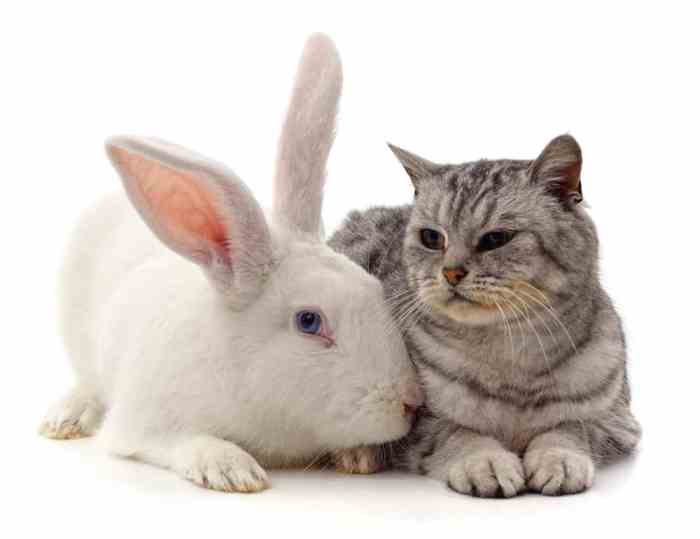Cats and rabbits are both popular pets, but can they live together harmoniously? The answer is not always straightforward. In this article, we will explore the factors that influence the compatibility of cats and rabbits, discuss potential challenges, and provide strategies for successful cohabitation.
Cats and rabbits have very different natural instincts and behaviors. Cats are predators, while rabbits are prey animals. This can create a natural tension between the two species. However, with proper socialization and management, cats and rabbits can learn to coexist peacefully.
Overview
Cats and rabbits are popular pets, but their ability to coexist harmoniously depends on various factors. Understanding their natural instincts and behaviors can help determine their compatibility.Cats are natural predators, while rabbits are prey animals. This innate difference can create challenges in their interactions.
However, with proper socialization and management, cats and rabbits can learn to tolerate or even enjoy each other’s company.
Compatibility Factors
The compatibility of cats and rabbits is influenced by various factors, including their age, socialization, temperament, personality, and previous experiences with other animals. Understanding these factors can help you determine if your cat and rabbit can coexist peacefully.
Age and Socialization
Kittens and young rabbits are more adaptable and easier to socialize than older animals. Early exposure to each other and positive experiences can help them develop a bond and reduce the likelihood of conflict.
Temperament and Personality
Cats and rabbits with calm and gentle temperaments are more likely to get along. Dominant or aggressive animals may view each other as threats, leading to territorial disputes or physical altercations.
Previous Experiences with Other Animals
Animals with positive experiences with other species are more likely to be accepting of new companions. However, those with negative experiences may be fearful or hostile towards other animals.
Potential Challenges
Introducing cats and rabbits requires careful consideration due to several potential challenges that may arise. These challenges stem from inherent differences in their behaviors, instincts, and communication styles.
Predatory Instincts
Cats possess a natural predatory instinct towards small animals, including rabbits. This instinct can be triggered by the rabbit’s movements, size, or even its scent. Even if a cat has never hunted before, it may still view a rabbit as potential prey.
Strategies for Successful Cohabitation

Cohabitation between cats and rabbits requires careful planning and implementation to ensure their well-being and minimize conflicts. Here are some strategies to promote successful cohabitation:
Gradual Introductions
Introduce the animals gradually to prevent sudden confrontations. Start by keeping them in separate rooms with their scent swapped through blankets or toys. Allow them to get accustomed to each other’s presence without direct contact.
Providing Separate Spaces and Resources
Provide separate spaces for each animal, including designated sleeping areas, litter boxes, and food and water bowls. This helps prevent territorial disputes and gives them a sense of security.
Monitoring Interactions and Addressing Potential Conflicts
Monitor interactions closely, especially during the initial stages. Address any signs of aggression or discomfort promptly. Separate the animals if necessary and consult with a veterinarian or animal behaviorist for guidance.
Additional Considerations
In addition to the compatibility factors and potential challenges discussed earlier, several other aspects should be considered when assessing the compatibility of cats and rabbits.
Health and Safety Concerns
Cats are natural predators, and rabbits are prey animals. This innate instinct can lead to conflict and potential harm if not managed properly. It’s crucial to ensure both pets are healthy and have regular veterinary check-ups to prevent the spread of any diseases.
Additionally, providing separate feeding and litter areas, as well as supervised interactions, can help minimize the risk of injuries.
Environmental Enrichment
Both cats and rabbits require a stimulating environment to thrive. Providing plenty of toys, hiding places, and interactive play sessions can help keep them entertained and prevent boredom. Consider the specific needs of each species when creating an enriched environment.
For instance, cats enjoy climbing and perching, while rabbits prefer digging and burrowing.
Long-Term Care and Responsibilities
Owning a cat or a rabbit is a long-term commitment. Before bringing these pets into your home, carefully consider the responsibilities involved. This includes providing regular veterinary care, a nutritious diet, a clean and comfortable living space, and plenty of attention and affection.
Be prepared to invest time and effort in their well-being throughout their lives.
Final Thoughts
Ultimately, whether or not cats and rabbits can get along depends on a number of factors. By carefully considering the compatibility factors, potential challenges, and strategies for successful cohabitation, you can increase the chances of a harmonious relationship between these two different species.
Q&A
Can cats and rabbits ever be friends?
Yes, cats and rabbits can be friends, but it is not common. It is more likely to happen if they are introduced to each other as kittens and rabbits. However, even if they are not friends, they can still learn to coexist peacefully.
What are the biggest challenges of having cats and rabbits together?
The biggest challenges are predatory instincts, territorial behavior, and communication barriers. Cats are natural predators, and rabbits are prey animals. This can create a natural tension between the two species. Additionally, cats and rabbits have different ways of communicating, which can lead to misunderstandings.
What are some tips for successfully introducing cats and rabbits?
Some tips for successfully introducing cats and rabbits include: – Gradual introductions – Providing separate spaces and resources – Monitoring interactions and addressing potential conflicts